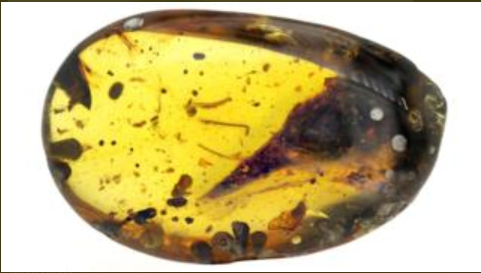
Scientists discovered an amber way back in 2016 that is a time-capsule of what looks like tiny dinosaurs. The fossils that were found in northern Myanmar possessing a bird-like skull gives several scientists a hypothesis that it is a dinosaur, a very tiny one. When it is compared to our most miniature birds known, the dinosaur fossil is no doubt smaller. The researchers have figured out the dinosaur date, and they say that it is inside the Mesozoic era.
Read More : Rare White Giraffe Mother and Calf Killed in Kenya: Could Anti-Poaching Drones Have Saved Them?
A paleontologist with the Chinese Academy of Sciences named Jingmai O'Connor says the discovery is mind-blowing and is something that none has seen before.
Mysterious Fossil
More details about the mysterious fossil unfold as researchers discover that the species had been alive 100 million years ago. The alleged dinosaur is said to have a length of 15 millimeters and has almost the size of a penny in the US.
Additional features that the fossil possesses is that it has a lot of teeth, which are mostly small. The particular fossil that has been preserved is also believed to be mature.
The newly found fossil has been awarded the name of "Oculudentavis khanga," which the first word means "eye-teeth-bird."
Specimen Research
The power of technology is now aiding researchers in the highest heights. Although it doesn't entirely mean that researchers won't do anything anymore, they are still required to do something for results to get out accurately.
The scanner used on the fossil enables the researches to see every tiniest bit of the sample even on a millimeter scale.
Oculudentavis' habit would also consist of insects, and despite having very small yet a large number of teeth, they are very strong biters.
Further assessment of the skull itself also pointed out that the Oculudentavis is a predator, O'Connor stated. O'Connor is also calling this bird-like creature as weird, yet it is still the oldest and tiniest flying predator the world has seen through fossils.
Gerald Mayr of the Senckenberg Research Institute in Frankfurt, Germany, also voiced his sentiments regarding the particular event. He said that the weirdness and uncertainty of the creature offer more different angles to the story. Mayr suggests that our years of avian understanding isn't just enough, and we are yet to discover more things about avian capabilities and their evolution.
Amber as a Time Capsule
The yellow resin that has been used by so many scientists and researches for years as a reference is a very useful time-capsule. Different paleontologists have also discovered many wonders while studying amber resins. It is more than just a time-capsule for them, but rather a gateway for opportunities and more scientific advancements.
Amber seems to have mastered the art of preserving any animals inside it, although anyone should understand that Amber cannot store bigger ones.
A biologist at the W.M. Keck Science Department named Lars Schmitz praises amber because of its contribution to humankind.
To improve the quality of amber fossil, it requires more time. However, what our current technology is offering right now is more than enough for paleontologists and researchers to deal with each discovery they come across.
ⓒ 2025 TECHTIMES.com All rights reserved. Do not reproduce without permission.




